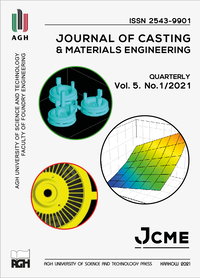Optimization of Blast Furnace Throughput Based on Hearth Refractory Lining and Shell Thickness
DOI:
https://doi.org/10.7494/jcme.2021.5.1.5Abstract
Computational analyses were performed to optimize the furnace throughput, steel shell and lining thickness of a blast furnace. The computations were done for measured parameters within the hearth region as this is the vital zone of the furnace with high temperature fluctuations, molten iron, and slag production. The lining materials were namely 62% high alumina (A), carbon composite (B), silicon carbide (C) and graphite bricks (D) with thermal conductivities 2, 12, 120 and 135 W/(m∙K), respectively. It was observed that by varying the refractory lining thickness from 0.2–0.35 m, and furnace inside temperatures from 1873–2073 K, certain optimal conditions could be specified for the furnace under consideration. Silicon carbide and graphite brick linings which have higher thermal conductivities, melting points, good chemical and mechanical wear resistance were observed to be the best hearth lining materials. Due to the high thermal conductivities of these two materials, the hot face temperature levels of the lining materials would be lowered. Amongst the four lining materials employed, silicon carbide and graphite bricks when used with lining cooling systems could optimize the blast furnace for better performance, production, and longer campaigns.
Downloads
References
Biswas A.K. (1981). Principles of blast furnace ironmaking. Cootha: Brisbane, Australia.
Hebel R., Steiger R. & Streuber C. (1994). Advanced materials for the blast furnace lining in regard to long service life, reasonable cost and theoretical qualification. Proceedings of 53rd Iron Making Conference, Chicago, March 20–23, AIME – Iron and Steel Society, USA, 397–406.
Briggs T.A. & Uzoma S.M. (2019). Heat load analysis for optimal use of cupula furnace in iron castings and steel manufacturing. European Journal of Mechanical Engineering Research, 6(1), 32–43.
Leimalm U. (2010). Interaction between Pellet Properties and Blast Furnace Operation. Luleå University of Technology, Luleå [Doctoral Thesis].
Dutta S.K. & Chokshi Y.B. (2020). Blast Furnance Process. In: Dutta S.K. & Chokshi Y.B., Basic concepts of Iron and steel making, Springer, 51–68.
Kumar D. (2015). Optimization of blast furnace parameters using artificial neural network. National Institute of Technology Rourkela-India [Masters Thesis].
Lamont P.H. (1996). Synthetic carbon and graphite – a modern material for the future. Furnace and Refractory Engineer, Autumn, 7–11.
Modigell M., Traebert A., Monheim P., Petersen S. & Pickartz U. (2001). A new tool for process modelling of metallurgical processes. Computers and Chemical Engineering, 25(4–6), 723–727. Doi: https://doi.org/10.1016/S0098-1354(01)00647-0.
Bhagat P.K. (2015). Optimization of refractory lining used in blast furnace. National Institute of Technology Rourkela-India [Masters Thesis].
Holman J.P. (1983) Heat transfer. Fifth Edition. McGraw-Hill International Book Company: New York.
Gdula S.J., Białecki R., Kurpisz K., Nowak A. & Sucheta A. (1985). Mathematical model of steady state heat transfer in the blast furnace hearth and bottom. Transactions ISIJ, 25, 380–385.
Downloads
Published
Issue
Section
License
Copyright (c) 2021 Chinwuba Victor Ossia, Shedrack Uzoma Mathew

This work is licensed under a Creative Commons Attribution 4.0 International License.


